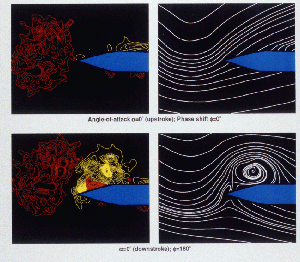You are here
Home ›Interactions of a Quasi-Two-Dimensional Vortex with an Oscillating Leading-Edge
Interactions of a quasi-two-dimensional vortex with an oscillating leading-edge. A turbulent vortex of positive (red) vorticity is generated by sinusoidal oscillation of a NACA 0012 airfoil located upstream of an oscillating leading-edge. Both the airfoil and edge oscillate at the same frequency, but with a controlled phase shift phi between them. Instantaneous vorticity distributions and streamline patterns are shown for the oscillating leading-edge at angle-of-attack alpha = 0° during its upstroke, in phase (phi = 0°) with the upstream airfoil, and during its downstroke, corresponding to out-of-phase (phi = 180°) motion of the airfoil. Contour levels of positive vorticity are one-fourth the value of negative (yellow) vorticity levels. As the incident vortex approaches the leading edge, a secondary vortex of negative vorticity grows to a relatively large-scale for the phi = 180° case, while it is barely detectable for the phi = 0° case. Furthermore, at phi = 180°, a tertiary vortex of positive sense arises from eruption of the surface boundary layer. The streamline pattern shows a more complex topology for the phi = 180° case, highlighting the dominance of the secondary vortex. These results clearly indicate that the phase between the incident vortex and the motion of the leading-edge can significantly alter the interaction process and suggest a means of control. [31]

